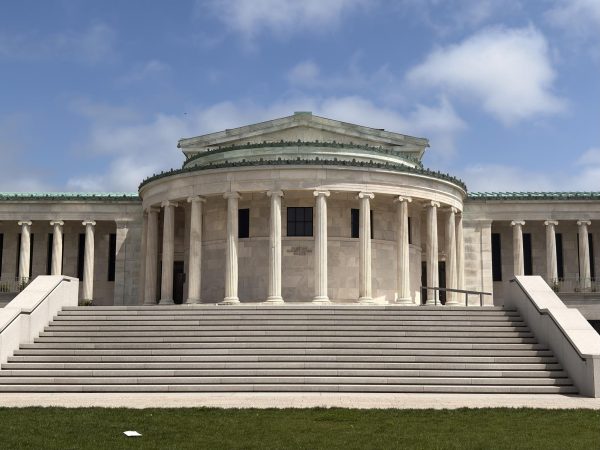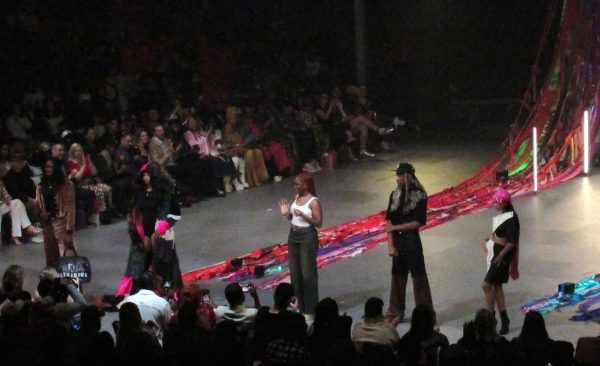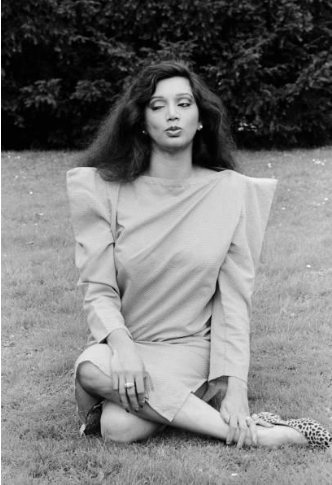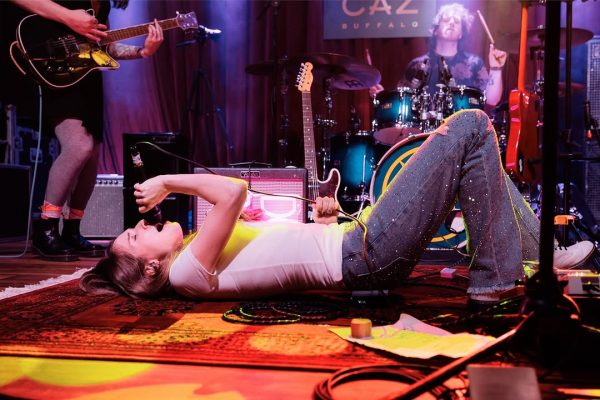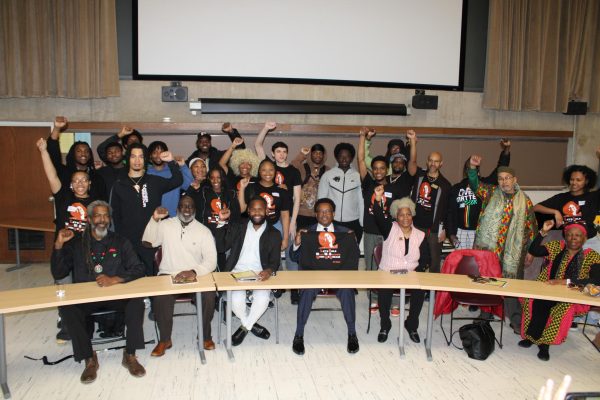Preserving a Culture: The untold story of Buffalo State’s ‘Monuments Men’ (and women)
Modern day art conservators thrive at Buffalo State under the legacy left by Sheldon and Caroline Keck
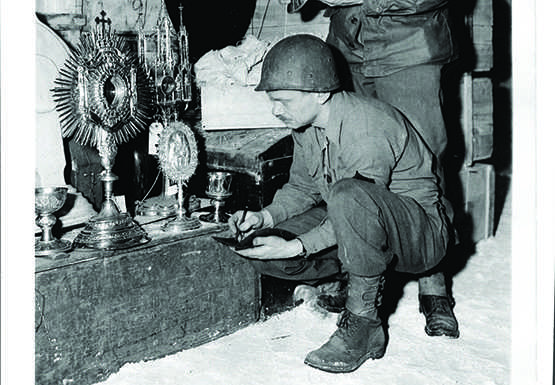
Courtesy of National Archives and Record Administration
Sheldon Keck, pictured above, laid the groundwork for the creation of what has become a nationally renowned art conservation department at Buffalo State. During World War II, Keck was among 350 ‘Monuments Men’ charged with finding preserving priceless artifacts that were left in the war’s destructive path. The stories of the men like Keck have been adapted into a major motion picture directed by George Clooney.
Inside the cavernous corridors of Rockwell Hall, beyond the boundaries of the Performing Arts Center and up the staircase into the building’s north wing is where this story begins.
Patrick Ravines, director of SUNY Buffalo State’s art conservation department, points to a black and white photo of an elderly couple that sits on the second of three shelves inside a glass case.
“They’re the reason we’re here,” he says.
The room across the hallway to his left will soon be dedicated in their name.
Underneath Ravine’s feet, back on the first floor, stand the double doors that lead to an area of campus many students will never see.
Here, an exclusive class of graduate students serve as understudies to the legacy left behind by the couple who revolutionized education in art conservation.
By this time next year, many of the seniors graduating from the program will secure jobs with the Library of Congress, the Metropolitan Museum of Art in New York City, the Smithsonian Museum in Washington, D.C.
The list goes on.
Name a prestigious American museum and it’s likely you’ll find a Buffalo State graduate who has helped to repair and preserve the cultural masterpieces that fill its galleries.
The couple in the picture, Sheldon and Caroline Keck, are the founders of Buffalo State’s art conservation department, which offers master’s degrees in art conservation. It is one of four such programs in the United States, three of which have roots that can be traced back to the Kecks.
From the picture on the second floor to the state-of-the-art studios and the department offices that house faculty who once studied under the Kecks, it’s all located at 1300 Elmwood Ave. because one couple was persistent about their vision to educate students about an emerging discipline.
The rest of this story plays out like a Hollywood film.
•••
Sheldon Keck and his partner and close friend Walter Huchthausen wandered into enemy territory on April 2, 1945, when their jeep came under gunfire about 30 miles east of Aachen, the first major German city captured by Allied forces.
The 1,100-year-old city and the outlying region was the epicenter of Charlemagne’s Holy Roman Empire and, by extension, was a hotbed for priceless artwork that had been housed in its many landmark churches.
As the city lay in ruins, Keck and Huchthausen set off to investigate reports of stolen altarpieces when they ventured too far.
The German infantry opened fire and hit Huchthausen, the driver of the vehicle, killing him instantly. His body knocked Keck to the floor of the jeep, saving his life.
A patrol of American soldiers later discovered Keck taking cover in a foxhole not far from the attack.
Allied forces accepted Germany’s unconditional surrender less than four weeks later.
Huchthausen became one of the 405,000 American casualties during the war, but he and Keck would ultimately be known for their actions behind the front lines rather than fighting on them.
They belonged to the Monuments, Fine Arts and Archives (MFAA) division, a group of 350 curators, architects, scholars and art conservators specially assembled to restore and preserve the priceless cultural works of art and record across Europe that fell in the war’s destructive path.
Huchthausen was one of two ‘Monuments Men’ who were killed in action while tracking paintings by Leonardo da Vinci, sculptures by Michaelangelo and archives of sacred documents during their World War II service.
The aforementioned scene with Keck and his partner has played out in front of the eyes of millions across the world over the past three weeks.
The previously untold stories of the MFAA are the focus of the major motion picture, “The Monuments Men,” George Clooney’s film adaptation of a 2009 book by the same title written by author Robert Edsel, which hit theaters earlier this month.
The movie stars a who’s who cast which includes Clooney, Matt Damon, Kate Blanchett, Bill Murray and John Goodman, who each portray real-life members of the ‘Monuments Men’ as they work to recover art stolen by Adolf Hitler and the Nazi regime.
And while Keck is not featured in the movie, the directors did include an adaptation of the scene where Huchthausen was killed, acted out by fictional French character Jean Claude Clermont and Walker Hancock, played by Goodman, as the two get lost before Clermont is shot and dies in Goodman’s arms.
The big-screen attention has shed light on the efforts of ‘Monuments Men’ like Keck, a story that has gone relatively untold since, apart from several published books detailing the experience.
Keck’s work overseas was not quite as glamorous as the Hollywood interpretation, but he did play an integral role in ensuring Hitler’s attempts to create a towering museum full of the stolen art fell flat.
Before being selected for the MFAA, Keck was a sergeant in the Ninth U.S. Army in the United States a year after beginning his service in 1943.
When the MFAA came calling, Keck entered Europe via Utah Beach not long after D Day in 1944. He advanced through France, as close as a kilometer behind the front lines, as Allied forces crossed into Germany.
There, it was Keck’s job to oversee the artifact recovery efforts in Marburg, a small town where Nazis stored thousands of works inside its copper mines. He restored paintings from mold and water damage from the damp storage space.
There were mines like these all over Germany, and the MFAA was charged with recovering as much as possible.
To this day, thousands of works of art remain unaccounted for, most famously the “Portrait of a Young Man” by Raphael. Many were likely burned and destroyed. Others continue to pop up in private collections around the world thank to the efforts of modern day conservators.
This, in part, is the reason the work of Sheldon Keck did not end with the war.
•••
Caroline Kohn was a character.
Even as she aged, those who mistook her petite stature and flirtatious nature for weakness were quickly caught off guard by her salty tongue and sharp wit that defined a powerful personality.
“She was a flapper,” said Jean Portell, an author based in Brooklyn currently working on a biography of the Kecks, who she knew personally for much of her life. “She knew a lot of fellows, but as she met Sheldon, she realized he was the only man she had met who knew exactly what he wanted to do. That impressed her.”
Sheldon, on the other hand, exuded a more reserved personality, whose emphasis on precision and tact in his work became his defining traits.
They met during a mutual class while attending Harvard, where Sheldon studied under Edward Waldo Forbes at the university’s Fogg Museum and Caroline worked toward her master’s.
By the accounts of those who knew the Kecks, their converse personalities were the driving factor to success in their careers and relationship.
Sheldon and Caroline Keck married in Manhattan City Hall on Halloween night, 1933. They took a brief honeymoon to the top of the newly-erected Empire State Building, but they didn’t waste much time getting to work after that.
A year later, Sheldon was hired at the Brooklyn Museum by a young director who envisioned the creation of an art conservation department, an unprecedented initiative at the time.
Here, he would work as a conservator (initially under the title of staff artist, due to city guidelines for funding) until 1961, with the only break being the three-year absence to serve in the war.
That’s when the Kecks shifted their attention to educating those interested in getting involved with the emerging field of work.
Sheldon accepted a position as director of the art conservation department at New York University, where he worked until the couple moved to Cooperstown to begin a graduate program of their own under the State University of New York system, in conjunction with SUNY Oneonta.
The Kecks mentored more than 150 conservators before moving to Buffalo State in the summer of 1987.
Among those who learned the techniques of art conservation in Cooperstown are three current Buffalo State professors who have helped carry out the Keck vision for education.
•••
Art conservationists of today are not necessarily tasked with navigating warzones, but the work they carry out is equally meaningful.
So what do modern art conservationists do?
“The term is conservator,” corrected Jonathan Thornton, one of the professors in the art conservation department who studied under the Kecks. “Conservationists apply to nature — trees, plants, that sort of thing.”
Thornton is joined by fellow professors James Hamm and Judith Walsh as descendants of the Kecks.
Modern day art conservators work for museums across the world, some establish private restoration businesses and others respond to rescue works in the path of natural disasters, such a Hurricane Katrina or Hurricane Sandy, which included the efforts of several Buffalo State students.
On a February afternoon back in Rockwell Hall, a handful of students work diligently on artwork, applying the ideals of the Kecks that have been passed down from the professors who learned from them first hand.
One hovers over a painting that spans the large table in front of her as she examines cracked oil paint that has begun to overtake the canvas. Another examines a jewelry box that dates back several hundred years.
The program often works with the Albright-Knox Art Gallery and Burchfield Penney Art Center to repair damaged artwork and restore old photos or sculptures within the museums.
The students selected into the program come from all over the country to learn here, hoping to further expand upon their undergraduate degrees in chemistry or art history and venture into a career that naturally gratifying.
Their collective mission is simple: preserve the works that define human culture so that it will forever be remembered in the original state.
Just as Sheldon and Caroline Keck, Buffalo State’s very own monuments man and woman, had intended.
Email: [email protected]


